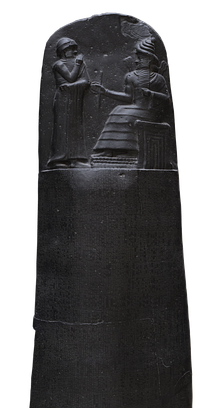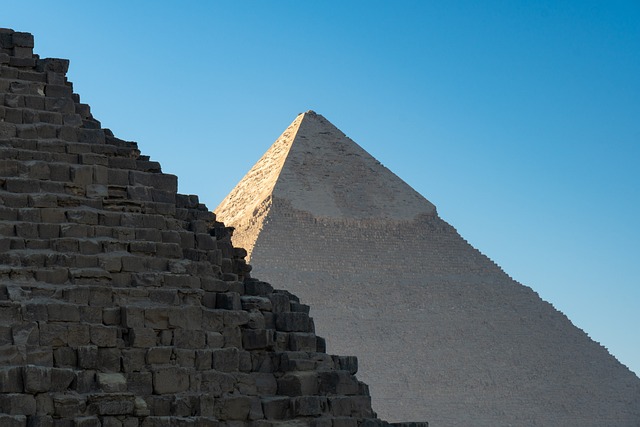The Punic Wars: A Saga of Power, Rivalry, and Mediterranean Supremacy
The Punic Wars stand as one of the most significant chapters in ancient history, symbolizing the clash of titans between Rome and Carthage for dominance over the Mediterranean. Spanning over a century, these conflicts reshaped geopolitics, economies, and societies, leaving an indelible mark on the ancient world. With roots in power struggles, trade ambitions, and territorial expansion, the Punic Wars encapsulate the complexities of international relations and the relentless pursuit of hegemony.

Rise of Carthage and Rome: Foundations of Mediterranean Power
The emergence of Carthage and Rome as dominant powers in the ancient Mediterranean laid the groundwork for centuries of conflict and competition. Their rise to prominence was marked by distinct characteristics, strategies, and ambitions, each shaping the course of history in its own right. From the Phoenician colony of Carthage to the city-state of Rome, their trajectories reflect the complexities of ancient geopolitics and the pursuit of power.
I. Carthage: The Maritime Empire of the Phoenicians
Situated on the coast of present-day Tunisia, Carthage evolved from a Phoenician trading outpost into a formidable maritime empire during the first millennium BCE. Founded around 814 BCE, Carthage capitalized on its strategic location to become a hub of trade and commerce in the western Mediterranean.
Carthage’s strength lay in its seafaring prowess, as its ships plied the waters of the Mediterranean, establishing trade networks that stretched from the Levant to the Iberian Peninsula. Through skillful navigation and diplomacy, Carthage controlled vital sea routes, monopolizing trade in commodities such as grain, metals, and precious goods.
The city’s economic prosperity was bolstered by its extensive territorial holdings across North Africa and the Iberian Peninsula. Colonies and trading posts dotted the coastline, serving as bases for commerce and military expansion. Carthaginian influence extended deep into the hinterlands, where alliances and client states ensured political stability and access to vital resources.
II. Rome: From City-State to Mediterranean Powerhouse
In contrast to Carthage’s maritime empire, Rome’s ascent to power was rooted in the Italian peninsula. Founded in the 8th century BCE, Rome began as a modest city-state inhabited by Latin tribes, situated on the banks of the Tiber River.
Rome’s rise to prominence was propelled by a combination of military prowess, political innovation, and strategic diplomacy. The Roman Republic, established in 509 BCE, introduced a system of checks and balances, with a complex hierarchy of magistrates, assemblies, and a senate, ensuring the distribution of power among the ruling elite.
Central to Rome’s expansion was its formidable military machine, comprised of citizen-soldiers known as legionaries. Through a combination of disciplined tactics, engineering prowess, and sheer determination, Rome steadily expanded its territory, subjugating neighboring tribes and cities in central Italy.
The conquest of the Italian peninsula provided Rome with a solid foundation for further expansion. By the 3rd century BCE, Rome had established hegemony over central Italy, incorporating conquered territories into its growing empire and assimilating diverse cultures and peoples into the Roman fold.
III. Convergence and Conflict: The Punic Wars
The convergence of Carthage and Rome on the stage of Mediterranean geopolitics set the stage for centuries of conflict and rivalry. The catalyst for confrontation lay in the strategic interests of both powers, particularly in the fertile lands of Sicily and the western Mediterranean.
The First Punic War (264–241 BCE) erupted over control of Sicily, sparking a protracted struggle for dominance. Despite Carthage’s naval supremacy, Rome’s innovative tactics and tenacity turned the tide of war, culminating in the defeat of Carthage and the imposition of harsh terms in the Treaty of Lutatius.
The Second Punic War (218–201 BCE) witnessed the legendary campaigns of Hannibal Barca, who crossed the Alps with his army and inflicted devastating losses on Rome at Trebia, Lake Trasimene, and Cannae. Despite Hannibal’s tactical brilliance, Rome’s resilience and strategic depth ultimately prevailed, leading to the defeat of Carthage at the Battle of Zama.
The Third Punic War (149–146 BCE) marked the final showdown between Rome and Carthage, culminating in the destruction of Carthage and the annexation of its territories. With the fall of Carthage, Rome emerged as the undisputed master of the Mediterranean, solidifying its position as the preeminent power in the ancient world.
Conclusion:
The rise of Carthage and Rome represents a pivotal chapter in the annals of ancient history, characterized by ambition, rivalry, and the pursuit of power. From humble beginnings, both civilizations ascended to greatness, leaving an indelible mark on the Mediterranean world and shaping the course of Western civilization.
The legacy of Carthage and Rome endures to this day, reminding us of the complexities of international relations, the dynamics of power, and the enduring quest for dominance in an ever-changing world. As we reflect on their legacies, we are reminded of the enduring lessons of history and the enduring impact of ancient civilizations on the modern world.
The First Punic War: A Turning Point in Mediterranean History
The First Punic War stands as a defining moment in ancient history, marking the onset of a series of conflicts that would shape the balance of power in the Mediterranean for centuries to come. Fought between the burgeoning powers of Rome and Carthage, the war was sparked by territorial disputes and commercial interests, ultimately leading to a struggle for supremacy over the strategic island of Sicily. Lasting for over two decades, the First Punic War witnessed dramatic naval engagements, epic land battles, and the emergence of Rome as a formidable maritime power.

I. Origins and Causes of Conflict:
The seeds of the First Punic War were sown in the complex web of alliances and rivalries that characterized the Mediterranean world in the 3rd century BCE. Sicily, with its fertile lands and strategic position at the crossroads of maritime trade routes, became the focal point of contention between Rome and Carthage.
In 264 BCE, tensions escalated when a dispute between Rome and a Carthaginian ally over control of the Sicilian city of Messana erupted into open conflict. Rome, seeking to expand its influence beyond the Italian peninsula, saw an opportunity to challenge Carthaginian dominance in the western Mediterranean.
II. Naval Warfare and Innovation:
The First Punic War witnessed a series of intense naval engagements that tested the military prowess and technological ingenuity of both Rome and Carthage. Carthage, renowned for its naval supremacy, initially held the advantage with its formidable fleet of warships and experienced sailors.
However, Rome, recognizing the importance of maritime dominance in the conflict, embarked on a massive shipbuilding program and developed innovative naval tactics to level the playing field. The introduction of the corvus, a boarding bridge affixed to Roman ships, allowed Roman soldiers to engage in close combat with Carthaginian crews, neutralizing Carthage’s naval superiority.
III. Land Battles and Sieges:
In addition to naval warfare, the First Punic War witnessed fierce land battles and protracted sieges as both Rome and Carthage sought to gain the upper hand in Sicily and other strategic territories. From the bloody confrontation at Agrigentum to the prolonged sieges of Syracuse and Lilybaeum, the conflict exacted a heavy toll on both sides.
Despite initial setbacks, Rome’s disciplined legions and strategic resilience enabled them to hold their own against Carthaginian forces on land. The introduction of new tactics, such as the manipular formation, allowed Roman armies to adapt to changing battlefield conditions and maintain their momentum against Carthaginian adversaries.
IV. The Turning Point: Battle of the Aegates Islands (241 BCE):
After decades of relentless warfare and attrition, the First Punic War reached a decisive turning point with the Battle of the Aegates Islands in 241 BCE. In a stunning display of naval prowess, the Roman fleet, under the command of Gaius Lutatius Catulus, inflicted a crushing defeat on the Carthaginian navy, effectively shattering Carthage’s maritime power.
The defeat at the Aegates Islands proved catastrophic for Carthage, forcing them to sue for peace on unfavorable terms. In the subsequent peace treaty, known as the Treaty of Lutatius, Carthage was compelled to cede Sicily to Rome, pay a substantial indemnity, and withdraw its forces from Sicilian waters. The treaty marked Rome’s emergence as a dominant force in the Mediterranean and signaled the decline of Carthaginian influence in the region.
Conclusion:
The First Punic War stands as a testament to the ambition, resourcefulness, and tenacity of both Rome and Carthage in their quest for supremacy in the ancient Mediterranean. From the crucible of conflict emerged a new geopolitical order, with Rome ascending as the preeminent maritime power of the western Mediterranean.
The lessons learned from the First Punic War would reverberate throughout antiquity, shaping the strategies and tactics of future military campaigns and influencing the trajectory of Mediterranean civilization. As subsequent conflicts unfolded, the legacy of the First Punic War would endure as a reminder of the enduring struggle for power and prestige in the annals of history.
Interwar Period and the Rise of Hannibal: Prelude to the Second Punic War
The interwar period between the First and Second Punic Wars was characterized by simmering tensions, territorial ambitions, and the emergence of charismatic leaders who would shape the course of history in the Mediterranean. For Carthage, the aftermath of the First Punic War was marked by a fervent desire to reclaim lost territories and challenge Rome’s growing dominance. At the center of Carthage’s resurgence was Hamilcar Barca, whose ambitions set the stage for one of history’s most audacious military campaigns led by his son, Hannibal Barca.
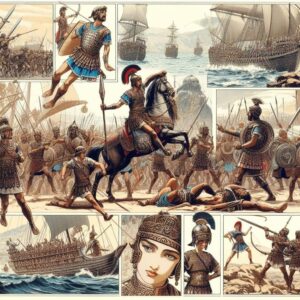
I. Consolidation and Expansion:
Following the conclusion of the First Punic War, Carthage found itself at a crossroads, grappling with the repercussions of defeat while seeking avenues for resurgence. Under the leadership of Hamilcar Barca, Carthage embarked on a campaign of consolidation and expansion, focusing its efforts on solidifying its holdings in North Africa and the Iberian Peninsula.
Hamilcar, a seasoned military commander and statesman, recognized the importance of securing strategic territories and resources to challenge Rome’s hegemony in the western Mediterranean. Through a combination of diplomacy, coercion, and military prowess, Hamilcar extended Carthaginian influence across the Iberian Peninsula, establishing a network of alliances and client states that served as a bulwark against Roman encroachment.
II. The Rise of Hannibal:
At the heart of Carthage’s resurgence stood Hannibal Barca, the eldest son of Hamilcar, whose formative years were shaped by the tumultuous aftermath of the First Punic War. Raised in the crucible of Carthaginian ambition and military tradition, Hannibal emerged as a visionary leader determined to avenge Carthage’s losses and challenge Rome’s supremacy in the Mediterranean.
Hannibal’s ascent to power was marked by his unwavering commitment to the Carthaginian cause and his strategic brilliance on the battlefield. Trained in the art of warfare from a young age, Hannibal honed his skills as a commander, mastering the intricacies of tactics, logistics, and psychological warfare.
III. The Second Punic War:
In 218 BCE, Hannibal orchestrated one of history’s most audacious military campaigns, leading his army—including war elephants—across the treacherous terrain of the Alps into Italy. The crossing of the Alps was a testament to Hannibal’s indomitable spirit and strategic acumen, catching Rome off guard and plunging the Italian peninsula into chaos.
The early years of the Second Punic War witnessed a series of stunning victories for Hannibal, including the battles of Trebia, Lake Trasimene, and Cannae, where Roman legions suffered catastrophic losses at the hands of Carthaginian forces. Hannibal’s tactical brilliance and ability to outmaneuver superior Roman armies stunned the ancient world, laying bare the vulnerabilities of Roman military power.
IV. Legacy and Impact:
The legacy of Hannibal’s campaign reverberated throughout antiquity, reshaping the geopolitical landscape of the Mediterranean and leaving an indelible mark on the annals of military history. Despite his remarkable successes, Hannibal ultimately fell short of his ultimate objective: the complete overthrow of Roman hegemony.
Nevertheless, Hannibal’s defiance and resilience inspired future generations of military leaders and statesmen, serving as a testament to the enduring spirit of Carthage and the timeless pursuit of freedom and self-determination. Hannibal’s legacy endures as a symbol of resistance against overwhelming odds and a reminder of the power of determination and strategic vision in the face of adversity.
Conclusion:
The interwar period between the First and Second Punic Wars witnessed the rise of Carthage’s most illustrious son, Hannibal Barca, whose daring exploits and strategic genius would forever alter the course of Mediterranean history. From the crucible of defeat emerged a leader whose indomitable spirit and unwavering resolve challenged the might of Rome and inspired generations to come. Hannibal’s journey serves as a testament to the enduring quest for freedom, glory, and the pursuit of greatness in the face of seemingly insurmountable odds.
The Second Punic War: Rome’s Triumph over Hannibal and Carthage
The Second Punic War stands as one of the most epic conflicts of antiquity, pitting the mighty Roman Republic against the formidable Carthaginian general Hannibal Barca. Spanning over a decade, the war witnessed a series of dramatic battles, stunning victories, and devastating losses that reshaped the geopolitical landscape of the ancient Mediterranean. Hannibal’s audacious invasion of Italy and Rome’s determined resistance culminated in the decisive Battle of Zama, marking the end of Carthage’s aspirations for dominance and solidifying Rome’s position as the preeminent power in the Mediterranean.
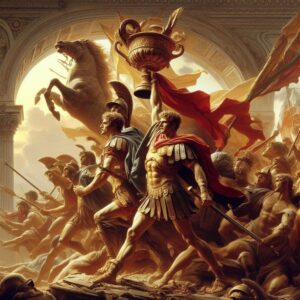
I. Hannibal’s Invasion and Early Triumphs:
Hannibal’s daring invasion of Italy in 218 BCE stunned Rome and its allies, as his army, including war elephants, traversed the treacherous Alps, catching the Roman forces off guard. The battles of Trebia, Lake Trasimene, and Cannae witnessed Hannibal’s tactical brilliance and the devastating effectiveness of his strategies, as he inflicted heavy casualties on superior Roman forces and shattered the confidence of Rome’s allies.
Hannibal’s ability to outmaneuver and outthink his adversaries showcased Carthage’s military prowess and posed a grave threat to Rome’s very existence. His unconventional tactics and strategic acumen earned him the admiration of friend and foe alike, solidifying his reputation as one of history’s greatest military commanders.
II. Rome’s Resilience and Strategic Response:
Despite the setbacks suffered at the hands of Hannibal, Rome demonstrated remarkable resilience and adaptability in the face of adversity. Roman generals such as Fabius Maximus adopted a strategy of attrition, avoiding direct confrontation with Hannibal’s forces while gradually wearing down Carthaginian resources and support.
The turning point of the war came with the emergence of Scipio Africanus, a visionary Roman general who recognized the need for a bold and decisive strategy to confront Hannibal on his own terms. Scipio’s daring invasion of North Africa diverted Carthaginian attention away from Italy and laid the groundwork for a climactic showdown at Zama.
III. The Battle of Zama and Carthage’s Downfall:
In 202 BCE, the forces of Scipio Africanus clashed with Hannibal’s army in the decisive Battle of Zama, near Carthage. Employing innovative tactics and exploiting Carthaginian weaknesses, Scipio inflicted a crushing defeat on Hannibal’s forces, effectively ending Carthage’s aspirations for Mediterranean hegemony.
The Treaty of Zama, negotiated under Roman terms, imposed harsh terms on Carthage, stripping it of its overseas territories, imposing heavy reparations, and placing it under Roman hegemony. Despite the humiliation and loss, Carthage endured, albeit as a shadow of its former self, while Rome emerged triumphant, solidifying its dominance over the Mediterranean world.
Conclusion:
The Second Punic War represents a seminal moment in ancient history, epitomizing the clash of civilizations and the struggle for supremacy in the Mediterranean. Hannibal’s audacious campaign and Rome’s determined resistance underscore the enduring legacy of human ambition, courage, and resilience in the face of adversity.
The lessons learned from the Second Punic War continue to resonate in the annals of military history, serving as a testament to the enduring spirit of conquest and the inexorable march of empires. As we reflect on the triumphs and tragedies of ancient conflicts, we are reminded of the timeless dynamics of power, ambition, and the human capacity for both greatness and folly.
The Third Punic War and the Demise of Carthage: Rome’s Final Triumph in the Mediterranean
The Third Punic War stands as a grim testament to the ruthlessness of ancient power politics and the destructive consequences of unchecked imperialism. Fought between Rome, the burgeoning superpower of the Mediterranean, and Carthage, the ancient maritime empire, the conflict culminated in the complete annihilation of Carthage, marking the end of one of antiquity’s greatest civilizations.
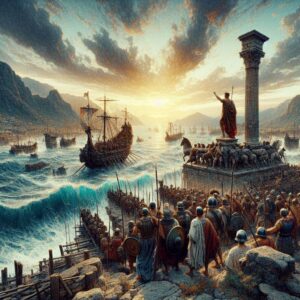
I. Background and Prelude to War:
Following the conclusion of the Second Punic War, Carthage, despite the loss of its overseas territories, remained a formidable economic and cultural center in the Mediterranean. However, Rome, wary of Carthage’s potential resurgence and seeking to eliminate any future threat to its dominance, sought pretexts to justify a military campaign against its ancient rival.
Rome’s pretext for war stemmed from alleged Carthaginian violations of peace treaties and the rearming of its military forces. Though Carthage attempted to comply with Roman demands and maintain peaceful relations, Rome’s hawkish factions prevailed, and war became inevitable.
II. The Siege and Destruction of Carthage:
In 149 BCE, Rome declared war on Carthage, launching a devastating assault on the city that would culminate in its utter destruction. The conflict, marked by sieges, naval blockades, and brutal warfare, saw Rome’s relentless determination to erase Carthage from the map once and for all.
The siege of Carthage, lasting three years, subjected its inhabitants to unimaginable suffering and deprivation. Despite valiant efforts to defend their city, the Carthaginians were ultimately overwhelmed by Rome’s superior military might and relentless siege tactics.
In 146 BCE, Roman forces breached the walls of Carthage, unleashing a wave of destruction and devastation upon the city. Carthage was razed to the ground, its buildings looted and burned, its citizens slaughtered or enslaved. The once-proud capital of Carthaginian civilization lay in ruins, a stark testament to the horrors of war and the inexorable march of empire.
III. Legacy and Consequences:
The destruction of Carthage marked the end of an era in Mediterranean history. The once-great maritime power that had challenged Rome’s dominance for centuries was no more, its legacy reduced to ashes and rubble.
For Rome, the victory over Carthage solidified its position as the preeminent power in the Mediterranean world. The annexation of Carthaginian territories further expanded Rome’s imperial reach, while the wealth and resources seized from Carthage enriched the coffers of the Roman Republic.
However, the destruction of Carthage also cast a long shadow over Rome’s legacy, serving as a grim reminder of the moral costs of conquest and the brutality of imperial expansion. The memory of Carthage’s downfall would haunt the Roman psyche for centuries, serving as a cautionary tale of the hubris and cruelty that accompany unchecked power.
The Third Punic War and the destruction of Carthage represent a dark chapter in the annals of human history, a testament to the folly of war and the fragility of civilization. The ruins of Carthage stand as a somber reminder of the impermanence of empires and the enduring legacy of conflict in shaping the course of nations.
As we reflect on the tragedy of Carthage’s demise, we are reminded of the enduring imperative to strive for peace, justice, and reconciliation in a world torn apart by strife and division. In honoring the memory of Carthage, we reaffirm our commitment to building a future where the lessons of history guide us toward a more peaceful and equitable world.
Conclusion:
The Punic Wars represent a pivotal period in ancient history, characterized by the collision of empires and the struggle for geopolitical supremacy. The enduring legacy of these conflicts reverberates through the annals of history, shaping the trajectory of civilizations and laying the groundwork for the rise of Rome as the preeminent power of the ancient world. The lessons gleaned from the Punic Wars—of ambition, rivalry, and the consequences of unchecked imperialism—continue to resonate in the study of international relations and the dynamics of power to this day.

